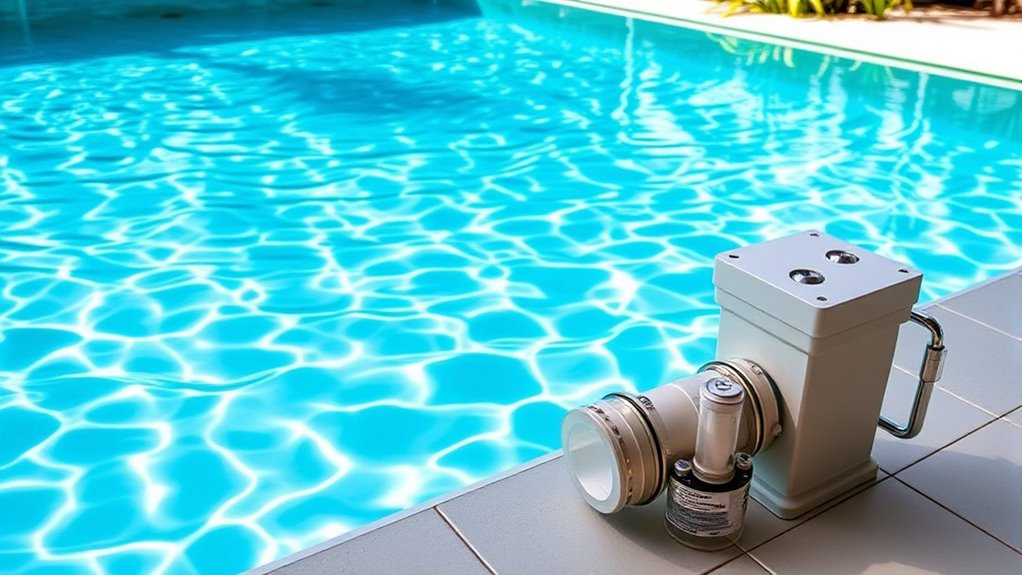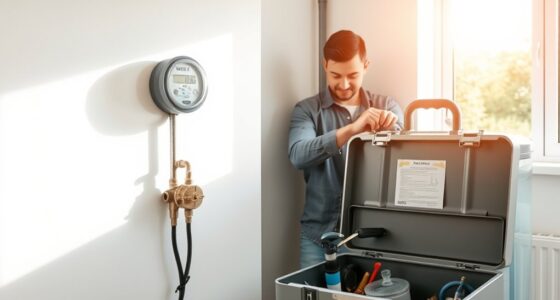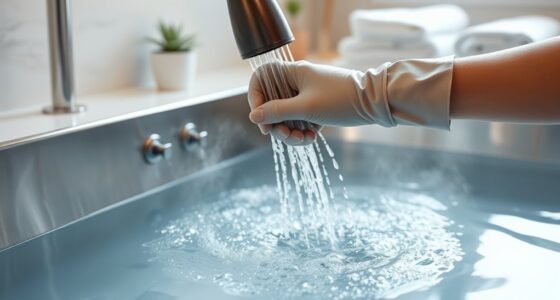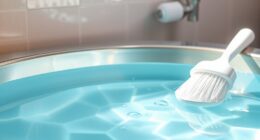To maintain water quality in your saltwater plunge pool, regularly check and balance the chemical levels, especially pH and salt content. Clean the salt cell monthly to prevent buildup, and monitor water circulation to keep the water clear and prevent algae. Proper filtration and consistent testing help sustain safe, clean water. By staying on top of these tasks, you ensure a healthy, inviting pool experience—more tips will help you keep it in perfect shape.
Key Takeaways
- Regularly inspect and clean the salt cell to prevent mineral buildup and ensure efficient chlorine generation.
- Maintain pH levels between 7.2 and 7.6 for optimal water balance and swimmer comfort.
- Monitor salt levels within 2700 to 3400 ppm to support proper chlorine production and system performance.
- Ensure consistent water circulation and filter cleaning to prevent stagnation and algae growth.
- Conduct routine water chemistry tests and adjust chemicals promptly to keep water clear and balanced.
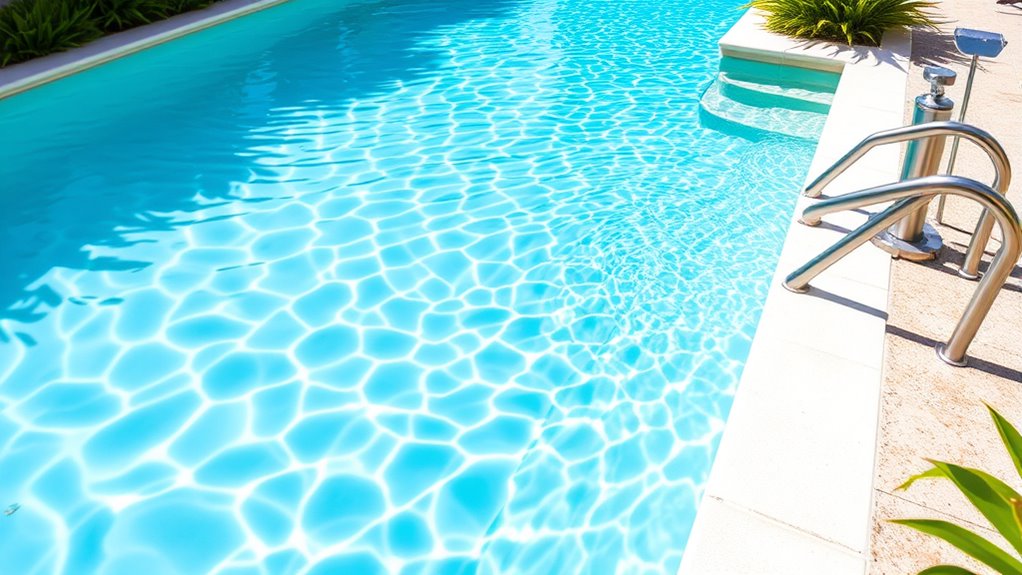
Maintaining water quality in a saltwater plunge pool is vital for safe and enjoyable swimming. One of the key aspects of this is proper salt cell maintenance. Your salt cell is the heart of your saltwater system, generating chlorine to keep the water sanitized. Over time, mineral buildup and debris can reduce its efficiency, leading to cloudy water or algae growth. Regularly inspecting and cleaning your salt cell ensures it functions at its best. You should remove any scale or buildup with a suitable cleaner, following the manufacturer’s instructions. Doing this monthly, or as recommended, keeps chlorine production steady and prevents issues that could compromise water quality.
Equally important is pH balancing. Maintaining the right pH level—typically between 7.2 and 7.6—is vital for the health of your pool and your skin. When the pH drifts out of this range, it can cause skin irritation, reduce the effectiveness of chlorine, and lead to scale formation or corrosion of pool components. To keep pH balanced, regularly test your pool water using reliable test strips or a digital tester. If the pH is too high, adding a pH reducer (usually muriatic acid or sodium bisulfate) will bring it down. Conversely, if it’s too low, a pH increaser like sodium carbonate (soda ash) can help restore balance. Small adjustments are often enough to keep the water within the ideal range.
Consistent monitoring is key. Check the pH level at least twice a week, especially during hot weather when evaporation can cause pH fluctuations. Likewise, keep an eye on salt levels, ensuring they stay within the recommended range for your system—usually around 2700 to 3400 ppm. Proper salt levels ensure your salt cell operates efficiently, producing enough chlorine without overworking the system.
Additionally, maintaining water circulation and filtration is essential. Good circulation prevents stagnation, reduces algae growth, and helps distribute chemicals evenly. Run your pump for the recommended hours each day, especially after heavy use or storms that introduce debris. Regularly cleaning your filter also prevents clogging and maintains proper flow.
In essence, staying on top of salt cell maintenance and pH balancing creates a healthy, crystal-clear swimming environment. It might require some routine effort, but it pays off in the long run, giving you peace of mind and more time enjoying your saltwater plunge pool. Proper care ensures your pool remains inviting, safe, and easy to maintain year-round. Regular system checks can help catch potential issues early before they affect water quality.
Frequently Asked Questions
How Often Should I Test My Saltwater Pool’s Water Chemistry?
You should test your saltwater pool’s water chemistry at least twice a week to guarantee proper chemical balance. Regular test frequency helps you catch imbalances early, preventing issues like algae growth or corrosion. Use a reliable test kit to monitor pH, chlorine, and salt levels, and adjust chemicals accordingly. Maintaining consistent testing keeps your saltwater plunge pool clean, safe, and inviting for every swim.
Can Natural Remedies Replace Chemical Treatments in a Saltwater Pool?
Natural remedies can support your saltwater pool’s health but shouldn’t fully substitute chemical treatments. Investigate how natural filtration and mineral balancing work together to maintain clarity and safety. While methods like UV sterilization or adding beneficial minerals may reduce chemical use, they often complement rather than replace traditional sanitizers. Relying solely on natural remedies risks imbalanced water quality, so a balanced approach ensures your pool stays clean, safe, and enjoyable.
What Are Common Signs of Water Quality Issues in a Saltwater Pool?
You’ll notice water quality issues when algae growth appears on pool surfaces or the water turns cloudy. These signs indicate your saltwater pool needs attention. Algae thrives in warm, nutrient-rich water, and cloudy water suggests imbalance or buildup of contaminants. Regularly check your salt levels, sanitizer, and filtration system. Prompt action, like brushing algae and shocking the pool, helps restore clarity and keeps your water safe and enjoyable.
How Does Climate Affect Maintenance Routines for a Saltwater Pool?
Climate can turn your saltwater pool into a high-maintenance garden maze. You’ll need to make seasonal adjustments to your routine, like adding more chlorine or balancing pH during hot, sunny months, and reducing it in cooler seasons. Climate-related challenges, such as heavy rain or wind, can introduce debris or dilute chemicals, so stay vigilant and adjust your maintenance schedule accordingly to keep your pool sparkling and inviting year-round.
Are There Specific Brands of Salt or Chemicals Recommended for Optimal Water Quality?
You should choose salt brand recommendations that are high purity and specifically designed for pools, like Morton or SeaKlear, to guarantee chemical compatibility. Always check labels for chemical compatibility to avoid adverse reactions. Using reputable brands helps maintain water quality, reduces maintenance issues, and minimizes the need for additional chemicals. Regular testing and balancing your pool’s chemistry will keep your saltwater plunge pool clean, clear, and inviting.
Conclusion
Keeping your saltwater plunge pool pristine is like tending a delicate oasis—each careful action is a drop of clarity in a clear, inviting lake. When you regularly test and balance the water, you’re nurturing a sanctuary where worries dissolve like ripples on the surface. Remember, your pool’s health reflects your care; with consistent maintenance, it becomes a shimmering mirror of tranquility, inviting you to plunge in serenity whenever you desire.
